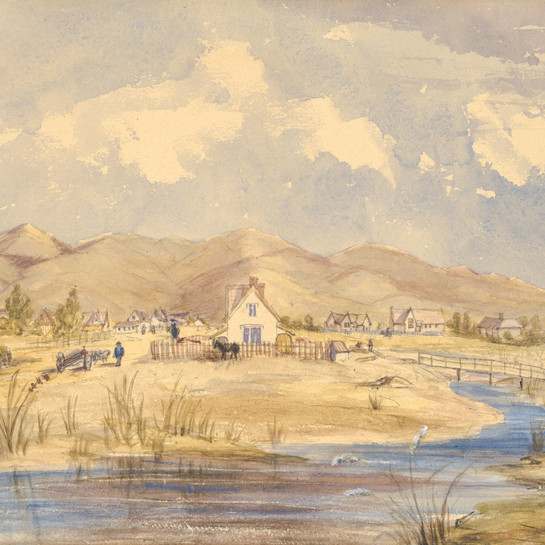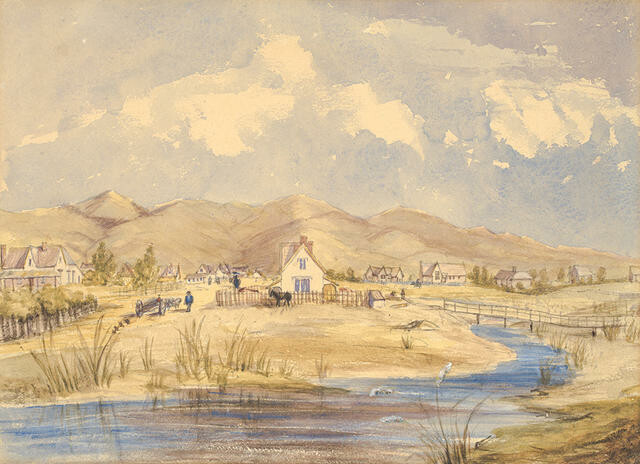Emily Harper
England / Aotearoa New Zealand, b.1830, d.1905
Christchurch from near the Gloucester Street Bridge
- 1857
- watercolour
- Gift of the Acland family, 2016
- 205 x 280mm
- 2016/032
- View on google maps
Tags: animals, bridges (built works), buildings (structures), carts, horses (animals), houses, people (agents), rivers, umbrellas
Emily Harper arrived in Lyttelton with her family in 1856. Aged twenty-six, she was the eldest of fifteen children of Christchurch’s first Anglican Bishop. She painted this view of the fledgling town in the following year. Emily left Christchurch in 1860 after marrying ex-London barrister John Acland (younger son of a British politician and baronet), who had taken up sheep farming in the Canterbury high country.
(Out of Time, 23 September 2023 – 28 April 2024)
The Ashburton Guardian, 24 July 1905, reported the death of Mrs Emily Acland (née Harper) as follows:
Mrs Acland, widow of the late Hon. J. B. Acland, died in Christchuroh this morning at tho age of 75, after a short illness. Mrs Acland was the eldest daughter of the late Bishop Harper, first Primate of New Zealand, mother of Mr J. D. Acland, sister of Mr C. J. Harper, and aunt to Mr P. H. Cox, all of Ashburton. Owing to her quiet, gentle manner and wonderful capacity for doing good to all around her, Mrs Acland was greatly respected and loved by all who knew her, and the loss caused by her death will be especially felt in the village of Peel Forest. Three sons and five daughters survive her. The funeral will take place at Mount Peel on Thursday afternoon next, 27th inst.
Exhibition History
Pickaxes and shovels, 17 February – 5 August 2018
New Zealand’s colonial treasurer Christopher Richmond wrote his impressions of Christchurch to his wife on his visit to Waitaha / Canterbury in October 1857, around the time this work was painted. From the summit of the Bridle Path, he saw “a little patch of scattered houses – a mere nothing in the vastness of the plain – no buildings of any elevation mark the town. […] The roads are long, straight and sandy. Over such a one we cantered into the town. There is not a complete street in the place. The town site is very extensive and the houses dotted all over it. […] There is not much choice in sites. The land is as flat as a pancake – treeless, featureless – except the little river. You may as well build in one place as another.”
![Andreas Cellarius Hypothesis Ptolemaica Sive Communis Planetarum Motus Per Eccentricos Et Epicyclos Demonstrans [The Ptolemaic Hypothesis or Common Representation Demonstrating the Planetary Motions through Eccentrics and Epicycles] 1661. Hand-coloured engraving. Collection of Christchurch Art Gallery Te Puna o Waiwhetū, William A. Sutton bequest, 2000](/media/cache/05/97/05970cdff0f6b3264062d69bf2aa90f5.jpg)

